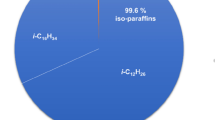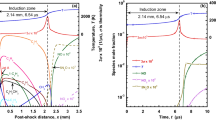Abstract
Emerging detonation-based combustors have motivated the study of the use of real distillate fuels for detonation devices. However, NOx emissions from real distillate fuel in a detonating environment have so far received very little attention. Therefore, it is essential to address the NOx emissions from a real distillate fuel in an extreme combustion environment as it can give us a strong set of information about the emission characteristics of detonation-based combustors. In the current study, NOx emissions were numerically studied for an alcohol-to-jet synthetic (C1) fuel for its potential application in detonation-based combustors. The study aims to enhance the qualitative understanding of the NOx emissions from a synthetic biofuel in detonation-based combustors. Also, primary methods of NOx reduction, such as the utilization of lean mixtures or dilution with inert diluents, are investigated in the present study for C1-air mixtures. For the mixtures and operating conditions featuring promising detonability, the formation of the oxides of nitrogen under detonating conditions has been studied using a detailed hybrid chemistry reaction model combined with the NOx model of Glarborg et al. The computations were carried out to cover a broad range of conditions where NOx emissions from stoichiometric C1-air detonations were studied. The computations were then extended to include the effect of the mixture's initial conditions, where the effects of varying equivalence ratios (φ), initial pressure (P0), and initial temperature (T0) on NOx emissions were studied. Additionally, computations were also carried out to study the effect of dilution on NOx emissions using inert gases such as argon and helium. The present study lays the groundwork for the optimized operation of liquid hydrocarbon-fueled detonation-based engines and enables an insight into the potential measures that can be employed for reduced NOx emissions in such devices.






Similar content being viewed by others
Abbreviations
- Δi :
-
Induction zone length (mm)
- τ i :
-
Induction delay time (µs)
- Δr :
-
Reaction zone length (mm)
- τ r :
-
Reaction time (µs)
- Δrecom :
-
Recombination zone length (mm)
- τ recom :
-
Recombination time (µs)
- T CJ :
-
Post-detonation temperature (K)
- T VN :
-
Post-shock temperature (K)
- NOx :
-
Oxides of Nitrogen (NO + NO2 + N2O)
- T 0 :
-
Initial temperature (K)
- P 0 :
-
Initial pressure (atm)
- φ :
-
Equivalence ratio (–)
References
Goodwin DG, Moffat HK, Speth RL (2009) Cantera: an object-oriented software toolkit for chemical kinetics, Caltech, Pasadena, CAhttps://doi.org/10.5281/zenodo.48735
Air Transport Action Group (ATAG) September 2011, Beginner’s Guide to Aviation Biofuels, Geneva
Anand V, Gutmark E (2019) A review of pollutants emissions in various pressure gain combustors. Int J Spray Combust Dyn 02(01):1–18. https://doi.org/10.1177/1756827719870724
Bowman CT (1975) Kinetics of pollutant formation and destruction in combustion. Prog Energy Combust Sci 01(01):33–45. https://doi.org/10.1016/0360-1285(75)90005-2
Browne S, Ziegler J, Shepherd JE (2008) Numerical solution methods for shock and detonation jump conditions, Pasadena, CA: GALCIT Report FM2006 6
Crane J, Shi X, Singh AV, Yujie T, Wang H (2018) Isolating the effect of induction length on detonation structure: hydrogen–oxygen detonation promoted by ozone. Combust Flame 200(01):44–52. https://doi.org/10.1016/j.combustflame.2018.11.008
Dahake A, Singh AV (2022a) A comparative study of critical detonation parameters for jet A and an alcohol-to-jet synthetic biofuel. In: AIAA SCITECH 2022a forum AIAA 2022-0819: 0819. https://doi.org/10.2514/6.2022-0819
Dahake A, Singh AV (2022b) Effect of fuel sensitization on NOx emissions from a synthetic biofuel under detonating conditions. In: AIAA SCITECH 2022b forum AIAA 2022-0518: 0518. https://doi.org/10.2514/6.2022-0518
de Nevers N (1995) Air pollution control engineering. Mc-Graw Hill, New York
Doring W (1943) On the detonation processes in gases. Ann Phys 43(01):421–436
Ferguson DH, O'Meara B, Roy A, Johnson K (2020) Experimental measurements of NOx emissions in a rotating detonation engine, AIAA SciTech Forum, Orlando, FLhttps://doi.org/10.2514/6.2020-0204
Frolov SM, Basevich VY, Aksenov VS, Gusev PA, Ivanov VS, Medvedev SN, Smetanyuk VA, Avdeev KA, Frolov FS (2011) Formation of nitrogen oxides in detonation waves. Russ J Phys Chem B 05(04):661–663. https://doi.org/10.1134/S1990793111040166
GEVO Inc. (2019) Sustainable aviation fuel. Englewood, Colorado
Glarborg P, Miller JA, Ruscic B, Klippenstein SJ (2018) Modeling nitrogen chemistry in combustion. Prog Energy Combust Sci 67(01):31–68. https://doi.org/10.1016/j.pecs.2018.01.002
Iyer MSK, Dahake A, Singh AV (2022) Comparative studies on ignition kinetics and detonation chemistry of real distillate fuels. Trans Indian Natl Acad Eng. https://doi.org/10.1007/s41403-022-00331-5
Iyer MSK, Singh AV (2021) NOx emissions from jet A-air detonations, AIAA 2021-3679, 2021 AIAA propulsion & energy forum, 9–11 August 2021, virtual eventhttps://doi.org/10.2514/6.2021-3679
Kumar DS, Singh AV (2021) Inhibition of hydrogen-oxygen/air gaseous detonations using CF3I, H2O, and CO2. Fire Saf J 124(01):1–13. https://doi.org/10.1016/j.firesaf.2021.103405
Kumar DS, Ivin K, Singh AV (2021) Sensitizing gaseous detonations for hydrogen/ethylene-air mixtures using ozone and H2O2 as dopants for application in rotating detonation engines. Proc Combust Inst 38(03):3825–3834. https://doi.org/10.1016/j.proci.2020.08.061
Kumar DS, Dahake A, Singh AV (2022) Detonation chemistry of fuel-sensitized jet A1-air detonations. Trans Indian Natl Acad Eng. https://doi.org/10.1007/s41403-022-00339-x
Lee JHS (2008) The detonation phenomenon. Cambridge University Press. https://doi.org/10.1017/CBO9780511754708
Neumann JV (1995) Theory of shock waves. World Scientific Publishing Co., River Edge
Ng HD, Higgins AJ, Kiyanda CB, Radulescu MI, Lee JHS, Bates KR, Nikiforakis N (2005) Non-linear dynamics and chaos analysis of one-dimensional pulsating detonations. Combust Theory Model 09(01):159–170. https://doi.org/10.1080/13647830500098357
Schwer DA, Kailasnath K (2016) Characterizing NOx emissions for air-breathing rotating detonation engines, AIAA propulsion and energy forum, Salt Lake City, UThttps://doi.org/10.2514/6.2016-4779
Shepherd JE (1986) Chemical kinetics of hydrogen-air-diluent detonations. Prog Astronaut Aeronaut 106(01):263–293. https://doi.org/10.2514/5.9781600865800.0263.0293
Stamps DW, Tieszen SR (1991) The influence of initial pressure and temperature on hydrogen-air-diluent detonations. Combust Flame 83(01):353–364. https://doi.org/10.1016/0010-2180(91)90082-M
Wang K et al (2018) A physics-based approach to modeling real-fuel combustion chemistry—IV. HyChem modeling of combustion kinetics of a bio-derived jet fuel and its blends with a conventional jet A. Combust Flame 198(01):477–489. https://doi.org/10.1016/j.combustflame.2018.07.012
Westbrook CK (1982) Chemical kinetics of hydrocarbon oxidation in gaseous detonations. Combust Flame 46(01):191–210. https://doi.org/10.1016/0010-2180(82)90015-3
Westbrook CK, Urtiew PA (1982) Chemical kinetic prediction of critical parameters in gaseous detonations. Proc Combust Inst 19(01):615–623. https://doi.org/10.1016/S0082-0784(82)80236-1
Yungster S, Radhakrishnan K, Breisacher K (2006) Computational study of NOx formation in hydrogen-fuelled pulse detonation engines. Combust Theory Model 10(06):981–1002. https://doi.org/10.1080/13647830600876629
Yungster S, Breisacher K (2005) Study of NOx formation in hydrocarbon-fueled pulse detonation engine, joint propulsion conference & exhibit, Tucson, Arizonahttps://doi.org/10.2514/6.2005-4210
Zeldovich YB (1940) On the theory of the propagation of detonation in gaseous systems. J Tech Phys (USSR) 10(01):542–568
Zeldovich YB (2006) To the question of energy use of detonation combustion. J Propuls Power 22(03):588–292. https://doi.org/10.2514/1.22705
Acknowledgements
The authors acknowledge the financial support for this work from the Aeronautics R&D Board, Ministry of Defence, Govt. of India vide Sanction Letter # ARDB/01/1042000M/I.
Author information
Authors and Affiliations
Corresponding author
Additional information
Publisher's Note
Springer Nature remains neutral with regard to jurisdictional claims in published maps and institutional affiliations.
Rights and permissions
Springer Nature or its licensor (e.g. a society or other partner) holds exclusive rights to this article under a publishing agreement with the author(s) or other rightsholder(s); author self-archiving of the accepted manuscript version of this article is solely governed by the terms of such publishing agreement and applicable law.
About this article
Cite this article
Dahake, A., Singh, R.K. & Singh, A.V. Nitrogen Oxides Emissions from a Bio-derived Jet Fuel Under Detonating Conditions. Trans Indian Natl. Acad. Eng. 8, 69–80 (2023). https://doi.org/10.1007/s41403-022-00378-4
Received:
Accepted:
Published:
Issue Date:
DOI: https://doi.org/10.1007/s41403-022-00378-4




